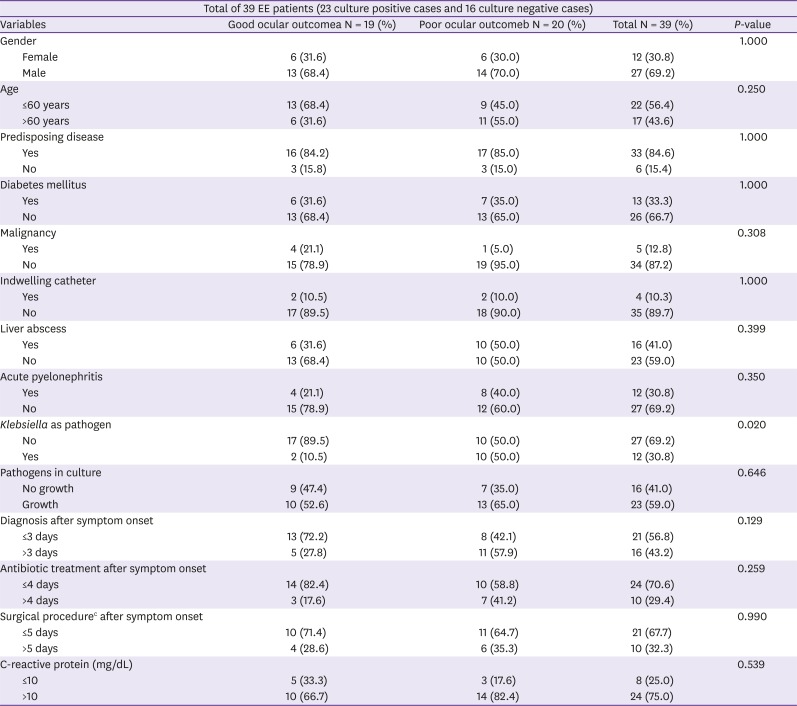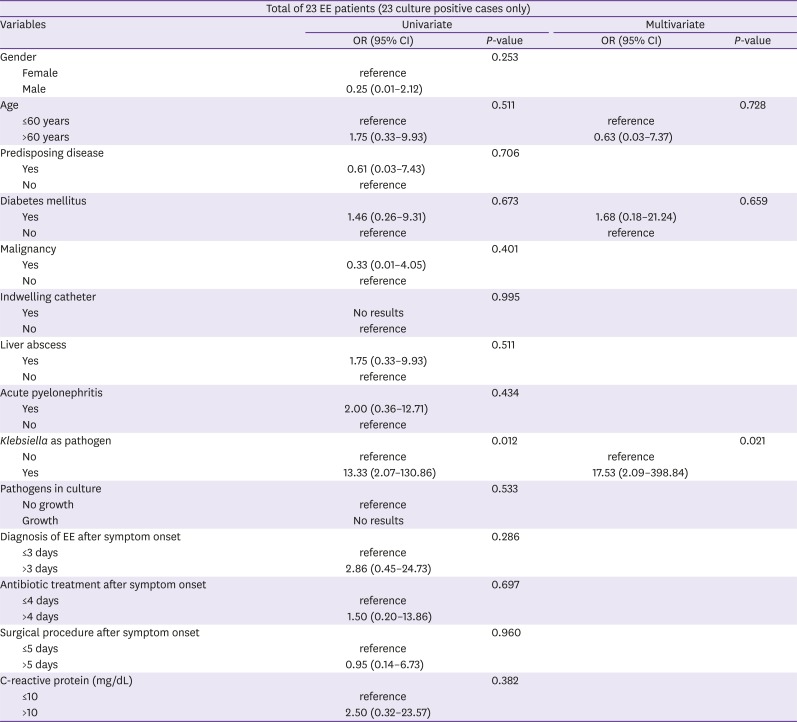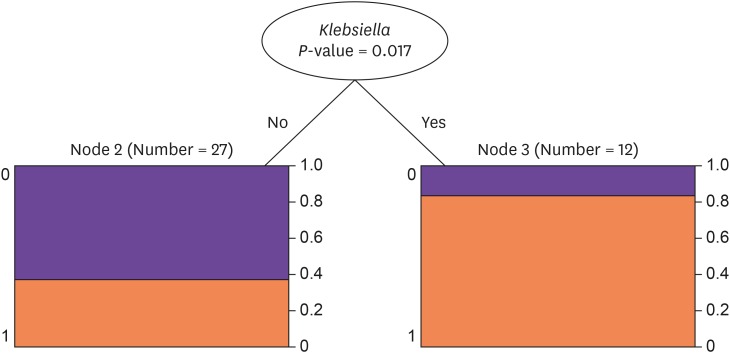1. Chee SP, Jap A. Endogenous endophthalmitis. Curr Opin Ophthalmol. 2001; 12:464–470. PMID:
11734687.

2. Jackson TL, Eykyn SJ, Graham EM, Stanford MR. Endogenous bacterial endophthalmitis: a 17-year prospective series and review of 267 reported cases. Surv Ophthalmol. 2003; 48:403–423. PMID:
12850229.

3. Ang M, Jap A, Chee SP. Prognostic factors and outcomes in endogenous Klebsiella pneumoniae endophthalmitis. Am J Ophthalmol. 2011; 151:338–344.e2. PMID:
21168820.

4. Connell PP, O'Neill EC, Fabinyi D, Islam FM, Buttery R, McCombe M, Essex RW, Roufail E, Clark B, Chiu D, Campbell W, Allen P. Endogenous endophthalmitis: 10-year experience at a tertiary referral centre. Eye (Lond). 2011; 25:66–72. PMID:
20966972.

5. Jackson TL, Paraskevopoulos T, Georgalas I. Systematic review of 342 cases of endogenous bacterial endophthalmitis. Surv Ophthalmol. 2014; 59:627–635. PMID:
25113611.

6. Lee S, Um T, Joe SG, Hwang JU, Kim JG, Yoon YH, Lee JY. Changes in the clinical features and prognostic factors of endogenous endophthalmitis: fifteen years of clinical experience in Korea. Retina. 2012; 32:977–984. PMID:
22105504.
7. Durand ML, Heier JS. Endophthalmitis. Curr Clin Top Infect Dis. 2000; 20:271–297. PMID:
10943529.
8. Yoon YH, Lee SU, Sohn JH, Lee SE. Result of early vitrectomy for endogenous
Klebsiella pneumoniae endophthalmitis. Retina. 2003; 23:366–370. PMID:
12824838.
9. Ishii K, Hiraoka T, Kaji Y, Sakata N, Motoyama Y, Oshika T. Successful treatment of endogenous
Klebsiella pneumoniae endophthalmitis: a case report. Int Ophthalmol. 2011; 31:29–31. PMID:
20661624.
10. Sallam A, Taylor SR, Khan A, McCluskey P, Lynn WA, Manku K, Pacheco PA, Lightman S. Factors determining visual outcome in endogenous
Candida endophthalmitis. Retina. 2012; 32:1129–1134. PMID:
22298012.
11. Lim HW, Shin JW, Cho HY, Kim HK, Kang SW, Song SJ, Yu HG, Oh JR, Kim JS, Moon SW. Endogenous endophthalmitis in the Korean population: a six-year retrospective study. Retina. 2014; 34:592–602. PMID:
24056527.
12. Hwang JH, Cho NC. Prognostic factors in patients with endogenous endophthalmitis. J Korean Ophthalmol Soc. 2009; 50:858–863.

13. Cho H, Shin YU, Siegel NH, Yu HG, Sobrin L, Patel A, Durand ML, Miller JW, Husain D. Endogenous endophthalmitis in the American and Korean population: an 8-year retrospective study. Ocul Immunol Inflamm. 2018; 26:496–503. PMID:
27459423.

14. Wong JS, Chan TK, Lee HM, Chee SP. Endogenous bacterial endophthalmitis: an east Asian experience and a reappraisal of a severe ocular affliction. Ophthalmology. 2000; 107:1483–1491. PMID:
10919895.

15. Takebayashi H, Mizota A, Tanaka M. Relation between stage of endogenous fungal endophthalmitis and prognosis. Graefes Arch Clin Exp Ophthalmol. 2006; 244:816–820. PMID:
16331481.

16. Wilhelmus KR, Specter S, Wilhelmus KR. Laboratory diagnosis of ocular infections: American Society for Microbiology. 1994.
17. Greenwald MJ, Wohl LG, Sell CH. Metastatic bacterial endophthalmitis: a contemporary reappraisal. Surv Ophthalmol. 1986; 31:81–101. PMID:
3541265.

18. Chang FY, Chou MY, Fan RL, Shaio MF. A clinical study of
Klebsiella liver abscess. Taiwan Yi Xue Hui Za Zhi. 1988; 87:282–287. PMID:
3397725.
19. Chee SP, Ang CL. Endogenous
Klebsiella endophthalmitis--a case series. Ann Acad Med Singapore. 1995; 24:473–478. PMID:
7574438.
20. Chiu CT, Lin DY, Liaw YF. Metastatic septic endophthalmitis in pyogenic liver abscess. J Clin Gastroenterol. 1988; 10:524–527. PMID:
3053874.

21. Lee CC, Chen CY, Chen FH, Zimmerman RA, Hsiao HS. Septic metastatic endophthalmitis from
Klebsiella pneumoniae liver abscess: CT and MR imaging characteristics--report of three cases. Radiology. 1998; 207:411–416. PMID:
9577489.
22. Liu YC, Cheng DL, Lin CL.
Klebsiella pneumoniae liver abscess associated with septic endophthalmitis. Arch Intern Med. 1986; 146:1913–1916. PMID:
3532983.
23. Wang FD, Wang LS, Liu YC, Liu CY, Lin CL, Wong WW. Successful treatment of metastatic endophthalmitis. Case reports. Ophthalmologica. 1989; 198:124–128. PMID:
2657535.
24. Sridhar J, Flynn HW Jr, Kuriyan AE, Dubovy S, Miller D. Endophthalmitis caused by
Klebsiella species. Retina. 2014; 34:1875–1881. PMID:
24801652.
25. Schiedler V, Scott IU, Flynn HW Jr, Davis JL, Benz MS, Miller D. Culture-proven endogenous endophthalmitis: clinical features and visual acuity outcomes. Am J Ophthalmol. 2004; 137:725–731. PMID:
15059712.

26. Essman TF, Flynn HW Jr, Smiddy WE, Brod RD, Murray TG, Davis JL, Rubsamen PE. Treatment outcomes in a 10-year study of endogenous fungal endophthalmitis. Ophthalmic Surg Lasers. 1997; 28:185–194. PMID:
9076791.

27. Ness T, Pelz K, Hansen LL. Endogenous endophthalmitis: microorganisms, disposition and prognosis. Acta Ophthalmol Scand. 2007; 85:852–856. PMID:
17725616.

28. Binder MI, Chua J, Kaiser PK, Procop GW, Isada CM. Endogenous endophthalmitis: an 18-year review of culture-positive cases at a tertiary care center. Medicine (Baltimore). 2003; 82:97–105. PMID:
12640186.
29. Fang CT, Lai SY, Yi WC, Hsueh PR, Liu KL, Chang SC.
Klebsiella pneumoniae genotype K1: an emerging pathogen that causes septic ocular or central nervous system complications from pyogenic liver abscess. Clin Infect Dis. 2007; 45:284–293. PMID:
17599305.
30. Liao HR, Lee HW, Leu HS, Lin BJ, Juang CJ. Endogenous
Klebsiella pneumoniae endophthalmitis in diabetic patients. Can J Ophthalmol. 1992; 27:143–147. PMID:
1586886.
31. Okada AA, Johnson RP, Liles WC, D'Amico DJ, Baker AS. Endogenous bacterial endophthalmitis. Report of a ten-year retrospective study. Ophthalmology. 1994; 101:832–838. PMID:
8190467.
32. Bohigian GM, Olk RJ. Factors associated with a poor visual result in endophthalmitis. Am J Ophthalmol. 1986; 101:332–341. PMID:
3485382.

33. Chen KJ, Hwang YS, Wang NK, Chao AN. Endogenous
Klebsiella pneumoniae endophthalmitis with renal abscess: Report of two cases. Int J Infect Dis. 2010; 14:e429–e432. PMID:
19656711.
34. Bouza E, Cobo-Soriano R, Rodriguez-Creixems M, Munoz P, Suarez-Leoz M, Cortes C. A prospective search for ocular lesions in hospitalized patients with significant bacteremia. Clin Infect Dis. 2000; 30:306–312. PMID:
10671333.









 PDF
PDF ePub
ePub Citation
Citation Print
Print






 XML Download
XML Download